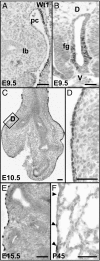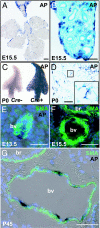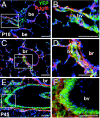Mesothelium contributes to vascular smooth muscle and mesenchyme during lung development
- PMID: 18922767
- PMCID: PMC2567908
- DOI: 10.1073/pnas.0808649105
Mesothelium contributes to vascular smooth muscle and mesenchyme during lung development
Abstract
During mouse development, the sophisticated vascular network of the lung is established from embryonic day (E) approximately 10.5 and continues to develop postnatally. This network is composed of endothelial cells enclosed by vascular smooth muscle, pericytes, and other mesenchymal cells. Recent in vivo lineage labeling studies in the developing heart and intestine suggest that some of the vascular smooth muscle cells arise from the surface mesothelium. In the developing lung, the Wilm's tumor 1 gene (Wt1) is expressed only in the mesothelial cells. Therefore, we lineage-labeled the mesothelium in vivo by using a Wt1-Cre transgene in combination with either Rosa26R(lacZ), Rosa26R(CAG-hPLAP), or Rosa26R(EYFP) reporter alleles. In all three cases, cells derived from lineage-labeled mesothelium are found inside the lung and as smooth muscle actin (SMA) and PDGF receptor-beta positive cells in the walls of pulmonary blood vessels. To corroborate this finding, we used 5-(and-6)-carboxy-2',7'-dichlorofluorescein diacetate, succinimidyl ester "mixed isomers" (CCFSE) dye to label mesothelial cells on the surface of the embryonic lung. Over the course of 72-h culture, dye-labeled cells also appear within the lung mesenchyme. Together, our data provide evidence that mesothelial cells serve as a source of vascular smooth muscle cells in the developing lung and suggest that a conserved mechanism applies to the development of blood vessels in all coelomic organs.
Conflict of interest statement
The authors declare no conflict of interest.
Figures





References
-
- deMello DE, Reid LM. Embryonic and early fetal development of human lung vasculature and its functional implications. Pediatr Dev Pathol. 2000;3:439–449. - PubMed
-
- Perez-Pomares JM, et al. Origin of coronary endothelial cells from epicardial mesothelium in avian embryos. Int J Dev Biol. 2002;46:1005–1013. - PubMed
Publication types
MeSH terms
Substances
Grants and funding
LinkOut - more resources
Full Text Sources
Other Literature Sources
Molecular Biology Databases
Research Materials

